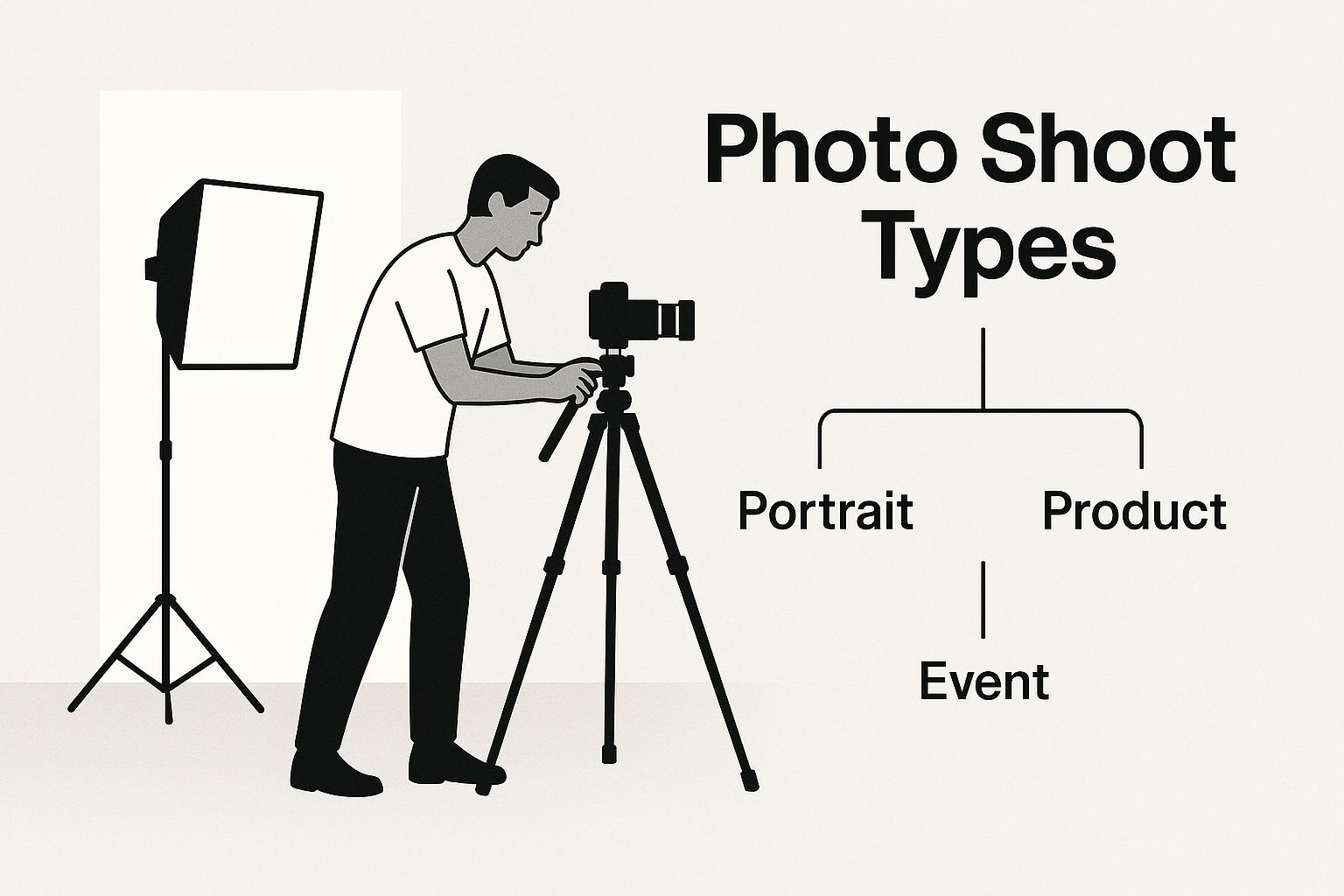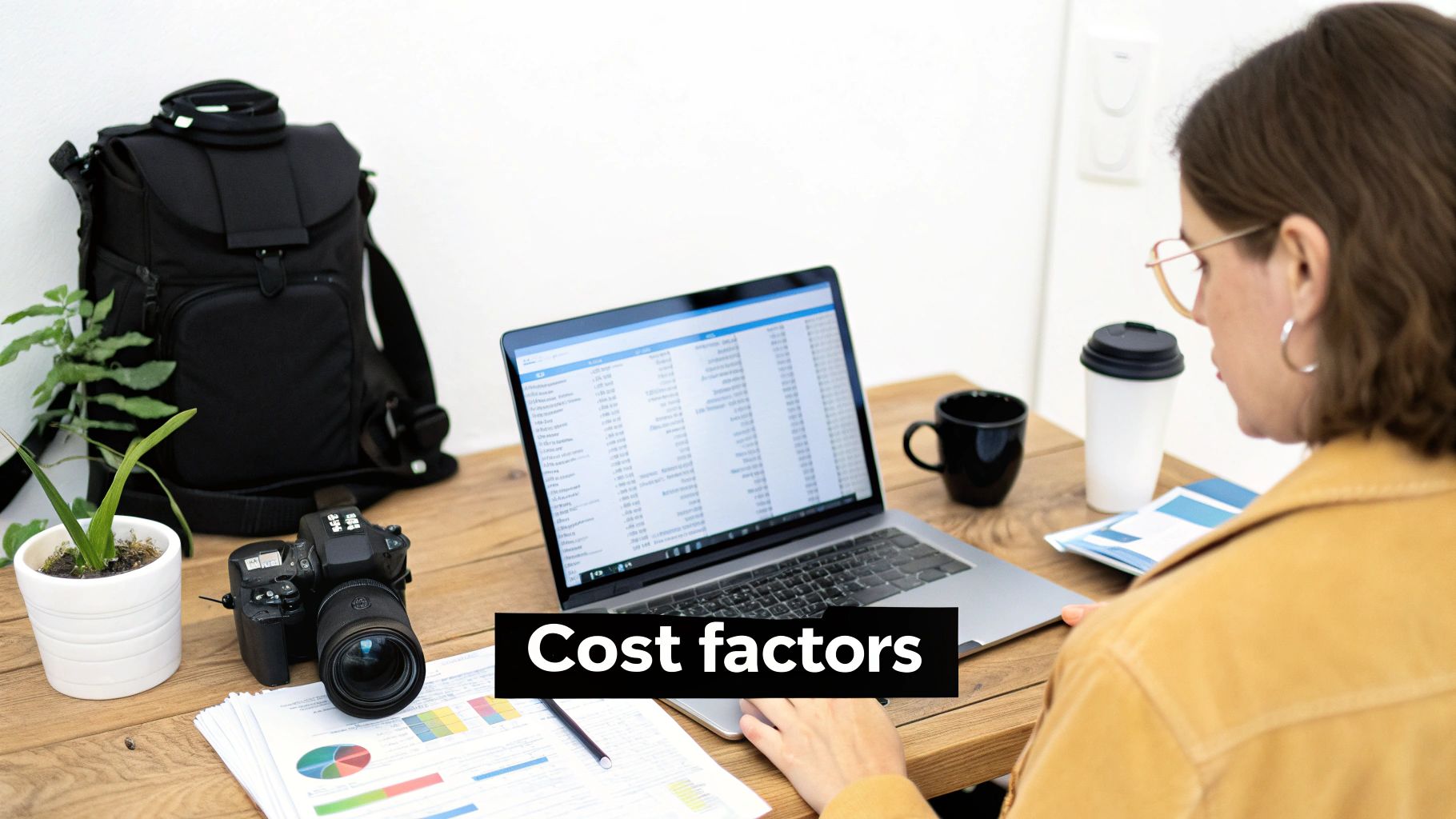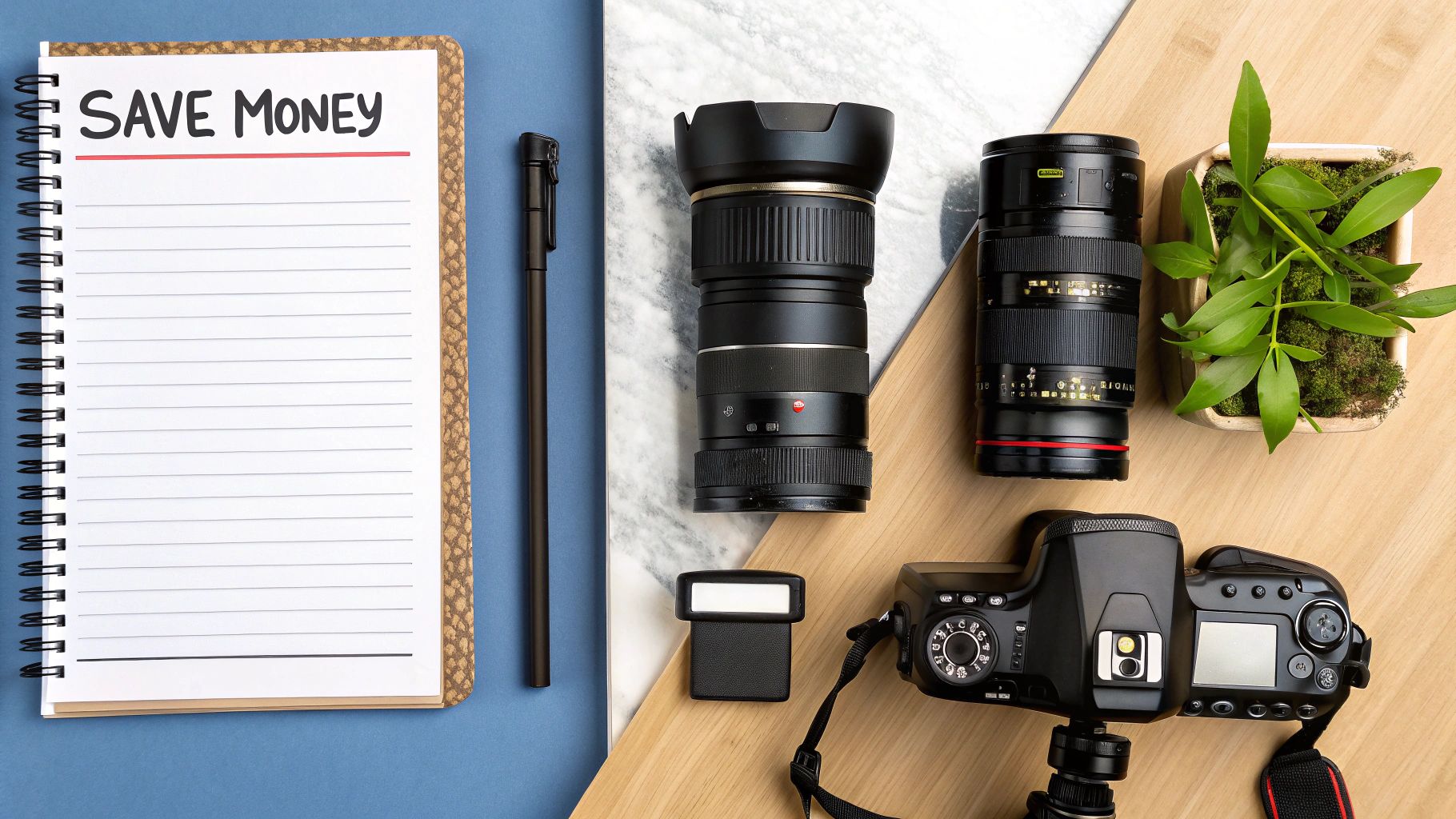So, what's the real cost of a professional photo shoot? The honest answer is… it depends. You could be looking at $150 for a quick headshot session or upwards of $3,500 for a photographer to capture your entire wedding day. It all comes down to the type of shoot, the photographer's experience level, and exactly what they're delivering in the final package.
A Snapshot of Typical Photo Shoot Prices
Thinking about photo shoot costs is a bit like comparing the price of a food truck taco to a five-course tasting menu. Both are food, sure, but the ingredients, the chef's skill, and the whole experience are worlds apart. You aren't just paying for someone to press a button; you're investing in their eye, their thousands of dollars in gear, and all the behind-the-scenes editing work that happens long after the cameras are packed away.
To give you a clearer picture, let's look at some common price ranges you're likely to see out in the wild.
Average Photo Shoot Price Ranges by Type
Here’s a quick summary of what you can generally expect to pay for different kinds of professional shoots. This should give you a solid benchmark as you start your search.
| Photo Shoot Type | Typical Price Range | What's Often Included |
|---|---|---|
| Portraits & Headshots | $150 – $600 | A 30-60 minute session, one or two locations, and a set number of retouched digital images. |
| Family Photos | $250 – $750 | A 1-2 hour session, often on-location, with a gallery of edited digital photos. Prints might be extra. |
| Engagement Photos | $300 – $1,000 | A 1-2 hour session, multiple outfits/locations, and a gallery of high-resolution images for save-the-dates. |
| Event Photography | $500 – $2,500+ | Billed hourly or as a package. Covers parties, corporate events, etc. Includes edited photos delivered digitally. |
| Wedding Photography | $1,500 – $5,000+ | All-day coverage (6-10 hours), a second shooter, an engagement session, and a full gallery of hundreds of edited photos. |
| Commercial/Product | $50 – $300+ per image | Varies wildly. Can be priced per photo, per hour, or on a day rate depending on complexity and usage rights. |
These numbers are a great starting point, but remember they can shift based on your location, the photographer’s demand, and many other factors.
Breaking Down the Benchmarks
Let's dive a little deeper into what drives these prices.
- Portrait and Headshot Photography: These are usually on the lower end because they're shorter and less complex. They're all about capturing a great shot of one or a few people efficiently. For a really focused look at this niche, this guide on typical headshot costs is a fantastic resource.
- Event Photography (Weddings, Parties): You'll see a big price jump here. That's because photographers are on their feet for long hours, navigating high-pressure moments, and then spending dozens of hours culling and editing to tell the story of a once-in-a-lifetime event.
- Commercial Photography: This is a whole different ballgame. It's often billed per image or on a day rate. Simple e-commerce product shots might be $35 per photo, while a more creative advertising campaign image could be well over $250.
It’s tempting to hunt for the lowest price, but that can be a risky move.
The easiest way to tell if a photographer is professional, reliable, and will provide good photography is their price. If they are priced too low, there is a very good chance they will do something that will make this investment not worth it.
Ultimately, these figures should help you set a realistic budget. If you want to get even more granular with pricing models and the factors that influence them, our full guide on the average photographer cost has a ton of valuable insights.
The 7 Key Factors That Drive Photography Prices
Ever wonder why one photographer quotes $300 for a portrait session while another, who seems pretty similar, quotes $3,000? It’s not just a random number they pull out of thin air. That final price is a careful calculation based on several key factors.
Once you understand what goes into it, you’ll see exactly what you’re paying for when you hire a pro.
Think of it like hiring someone to build a deck. A simple, small platform is going to cost way less than a multi-level structure with built-in lighting and custom railings. They're both decks, sure, but the time, skill, materials, and complexity are worlds apart. Photography works the exact same way.
1. Photographer Experience and Expertise
This is the big one. A seasoned pro with a decade of experience, a signature style, and a portfolio full of high-profile clients will naturally charge more than someone just starting out.
You’re not just paying for a person with a camera. You’re paying for their creative eye, their technical mastery, and their ability to handle anything you throw at them—from tricky lighting to a toddler having a meltdown. An experienced photographer delivers incredible results, every single time. That consistency is a skill built over years.
2. Shoot Duration and Complexity
It sounds obvious, but the more time a photographer spends on your shoot, the more it will cost. A quick 30-minute headshot session in a studio is a completely different beast than a full-day wedding that requires 10 hours of non-stop coverage.
Complexity adds another layer. A simple family portrait in a park needs minimal setup. On the other hand, a commercial product shoot might demand intricate lighting, specific props, and even a stylist. The more moving parts, the higher the cost.
- Simple Shoot: A one-hour session with one person at one location.
- Complex Shoot: An eight-hour event with multiple locations, a huge group, and unpredictable conditions.
3. Location and Travel Logistics
Where the photo shoot happens matters. A session at the photographer’s studio or a nearby park is usually straightforward. But if you have your heart set on a location that requires a permit, an entrance fee, or a long drive, those costs get baked into the final price.
Most photographers include travel within a certain radius (say, 25 miles) in their base package. Anything beyond that usually comes with a per-mile fee to cover their time and gas.
4. Number of Edited Images
Here’s a common misconception: you don’t pay for every single photo taken. What you’re really paying for are the final, professionally edited images. The editing process is where the magic really happens—color correction, blemish removal, and artistic tweaks are what turn a good photo into a great one. And that takes time.
A package that includes 5-10 retouched images will cost a whole lot less than one that delivers a gallery of 50-100 fully edited photos. More images simply mean more hours in front of the computer for the photographer.
The infographic below gives you a nice visual breakdown of how different shoots demand different levels of effort, which all ties back to the price.

As you can see, a simple headshot is way less involved than a commercial shoot, which often requires a whole team and a ton of planning.
5. Image Usage Rights and Licensing
How you plan to use the photos is a massive deal, especially for commercial work.
Image licensing dictates where and how you can legally use the photos. Personal use (like printing them for your home or posting on your personal social media) is standard for things like portraits and weddings. Commercial use (for ads, websites, or products) requires a different, more expensive license because those images are actively helping you make money.
6. Post-Production Time and Effort
Post-production is more than just basic editing. We're talking about advanced retouching, creating composite images, or designing a full-blown wedding album from scratch. These specialized services demand extra hours and a high level of artistic skill, which adds to the total cost.
If you’re curious how photographers figure all this out, a good freelance rate calculator can give you a peek behind the curtain at the business side of creative work.
7. Additional Crew and Equipment
Finally, some shoots are too big for one person to handle. A large-scale commercial project or a high-end fashion shoot might need a whole crew:
- Assistants: To wrangle lighting and equipment.
- Second Shooters: Absolutely essential for capturing multiple angles at big events like weddings.
- Stylists: For hair, makeup, and wardrobe.
- Specialized Gear: Things like high-powered lights, drones, or unique lenses that might need to be rented.
Every extra person or piece of rented gear is another line item that helps answer the question, "how much does a photo shoot cost?"
What Different Types of Photography Cost
Let's be honest: not all photo shoots are the same. You wouldn't expect a simple cupcake and an elaborate, five-tiered wedding cake to cost the same, right? Photography works the same way. Different styles demand unique skills, specialized gear, and vastly different time commitments, and all of that is baked into the final price.
Getting a handle on what goes into each niche—like wedding, portrait, or commercial photography—is the key to figuring out what a fair price looks like for what you need. When you know what’s driving the cost, you can line up your budget with your expectations without any surprises.

Wedding Photography: The Big Investment
Wedding photography is almost always the biggest line item in the photography world, and for good reason. Your wedding photographer isn't just snapping pictures. They’re a storyteller, a coordinator, and the person responsible for documenting a live, one-shot-only event. There are no do-overs.
That premium price tag covers a mountain of work that happens long before and after the "I do's." Think pre-wedding meetings, location scouting, and the high-stakes wedding day itself, which easily runs 8-10 hours. Then, the real work begins: sifting through thousands of shots and pouring dozens of hours into meticulously editing the final collection.
Here’s what typically drives the cost for weddings:
- How Long They're There: A full-day package covering everything from getting ready to the final dance will cost much more than a two-hour elopement session.
- A Second Photographer: Want another pro to catch different angles and candid moments? It’s a fantastic add-on, but it will bump up the price.
- The Extras: Things like premium photo albums, an engagement shoot, and print packages all add to the final investment.
Family and Portrait Photography: Capturing Milestones
Family and portrait sessions are all about freezing a specific moment in time. It could be a glowing maternity photo, a newborn’s first few days, or that yearly family picture for the holiday card. These shoots are usually shorter and way less complicated than a wedding, and their more accessible price point reflects that.
Still, prices can swing wildly in this category. A quick 30-minute mini-session at a local park will be on the lower end. On the other hand, a highly stylized newborn session with tons of props, custom backdrops, and multiple hours in a studio will naturally cost more.
According to the State of the Photography Industry report, family photography sessions often land between $600 and $800. Portrait photography has a much wider range, from $175 all the way up to $1,500. Weddings, not surprisingly, are the priciest, with average packages falling between $2,400 and $4,000.
It’s also super common for photographers in this space to offer videography. If you’re thinking about motion, our guide on hiring a videographer is a great place to start.
Commercial Photography: It's All About Business
Commercial photography is a completely different ballgame with its own set of rules for pricing. You're not just creating personal memories here; you're creating images designed to sell a product, promote a brand, or market a service. The value of these photos is tied directly to their ability to make money for a business.
Pricing is usually figured out based on a few key things:
- Usage Rights: This is the big one. A license to use a photo in a global ad campaign is going to cost exponentially more than the rights for a small business to post it on their Instagram.
- Production Complexity: This bucket includes all the moving parts—hiring models, stylists, renting a location, getting permits, and bringing in specialized gear.
- Per-Image vs. Day Rate: For straightforward product shots, you might pay per photo. For more involved lifestyle or branding shoots, photographers often charge a flat day rate.
Whether you're looking for specialized Product Photography Services for an e-commerce store or a new set of headshots, the pricing model is always built to reflect the value, skill, and resources needed to get the job done right.
The Hidden Costs of a Commercial Photo Shoot
When a brand starts asking, "how much does a photo shoot cost?", it's easy to focus on just the photographer. But for a commercial shoot, that’s just the tip of the iceberg. Unlike a simple headshot session, a commercial project is a full-blown production. The photographer is just one player on a much bigger team, and their invoice is only one slice of the total investment.
Getting your head around this from the start is absolutely key to setting a budget that isn’t pure fantasy. The final price tag is a reflection of a huge collaborative effort. Think of it less like hiring a painter and more like funding a small film crew for the day.
The Team Behind the Camera
For a commercial project to really land, you need a whole crew of specialized pros working together. Each person brings a specific skill to the table that photographers just don't cover. Trying to skimp on these roles doesn't just hurt the quality of the final images—it can grind the whole project to a halt.
You'll almost always need to budget for these essential team members:
- Models: Professional talent, usually sourced from agencies. Their fees swing wildly based on their experience and how big the campaign is.
- Wardrobe Stylists: They're the ones who select, source, and style every piece of clothing and accessory to match the brand’s vision.
- Prop Stylists: These pros are in charge of sourcing and arranging everything that isn't wearable to create the perfect mood and setting.
- Hair & Makeup Artists (HMUA): They make sure the models look consistently flawless, even under the unforgiving glare of studio lights.
Every single one of these roles is a separate line item in your budget. Trust me, trying to cut corners here is a false economy that always, always shows in the final product.
Production and Logistical Expenses
Okay, so you’ve got your creative team. But what about actually making the shoot happen? There’s a mountain of logistical costs that are incredibly easy to overlook but are the foundation of a smooth shoot day.
A classic mistake is underestimating the production side of things. Nailing down the right location, renting that one specific light, and even just feeding the crew are non-negotiable costs that make or break a shoot.
Here are some common production costs you can't ignore:
- Location Fees and Permits: This could be renting a studio, a cool-looking house, or getting city permits to shoot in a public park.
- Specialized Equipment Rentals: Think high-end lighting rigs, specific camera lenses, or custom backdrops that go way beyond a photographer’s standard kit.
- Catering and Craft Services: An 8-to-12-hour day is long. Keeping a crew of 5-10 people fed, hydrated, and happy is essential.
- Insurance: Liability coverage isn't just a good idea; it's a professional necessity.
To give you a real-world picture, let's look at the costs for a mid-tier commercial or fashion photo shoot.
Sample Budget Breakdown for a Mid-Tier Commercial Shoot
Here’s an itemized look at the various expenses that add up to the total cost of a professional shoot. It shows how the photographer's fee is just one part of the bigger financial picture.
| Expense Item | Typical Cost | Purpose |
|---|---|---|
| Photographer's Fee | $3,500 | Covers shooting, creative direction, and basic editing. |
| Models (2) | $2,500 | Professional talent fees for a full day. |
| Wardrobe & Prop Stylist | $2,000 | Sourcing, styling, and managing all clothing and props. |
| Hair & Makeup Artist | $2,000 | On-set hair and makeup services for the entire day. |
| Location & Permits | $1,000 | Studio rental or fees for securing an on-location spot. |
| Equipment Rental | $500 | Specialized lighting, lenses, or grip gear. |
| Catering/Craft Services | $500 | Food and drinks for the entire cast and crew. |
| Total Estimated Cost | $12,000 | The realistic investment for a high-quality shoot. |
As you can see, a project with a final price tag of around $12,000 is pretty standard. The photographer might take home $3,500, but another $8,500 goes to the other talent and logistics that make it all possible.
With so many moving parts and people involved, a rock-solid agreement is vital. Our freelancer contract template is a great place to start to make sure everyone's roles, responsibilities, and payments are crystal clear from day one.
Finding a Photographer That Fits Your Budget
Alright, so you've got a handle on what goes into a photographer's price tag. Now for the fun part: finding the right creative partner who can bring your vision to life without breaking the bank.
This isn't just about hunting for the cheapest deal. It’s about finding the best value for what you truly need. With a solid plan, you can skip the guesswork and find a pro whose work you absolutely love.
First things first, you need to know exactly what you're looking for. Before you even type a single search query, get crystal clear on your goals.
- What's the why? Are these shots for your personal brand? Family memories to hang on the wall? A big commercial product launch?
- What's the vibe? Are you dreaming of a style that’s bright and airy, dark and moody, or more candid and in-the-moment?
- What do you need back? Think about the final deliverables. How many edited images are you expecting? Do you need prints, or maybe a full-blown album?
Having the answers to these questions will make your search a million times easier. It also helps you communicate your vision clearly, so photographers know right away if they're a good fit.

Where to Look for Photographers
A simple Google search is a decent starting point, but don't let that be your only move.
Visual platforms like Instagram and Pinterest are absolute goldmines. You can search by hashtags specific to your area and the type of shoot you want (think #chicagoweddingphotographer or #austinfamilyportraits). This is the fastest way to get a feel for a photographer’s current work and their overall aesthetic.
And don't sleep on your own network! Ask friends, family, or even colleagues for referrals. A personal recommendation is often the best way to find someone who is not only talented but also reliable and great to work with.
Vetting Potential Candidates
Once you've got a shortlist of a few photographers you like, it's time to do a little homework. Really dig into their portfolios. You're looking for consistency in their editing style and proof that they can capture the kinds of moments you’re after. A strong portfolio should feel cohesive and scream "expert" in the specific type of photography you need.
When you're scrolling through their work, ask yourself this: Does this photographer consistently nail it in different lighting situations and settings? A truly great photographer can create stunning images no matter what the conditions are—a skill that only comes with years of real-world experience.
Finally, set up a quick call. This is your chance to see if your personalities click and to get a read on their professionalism. Have a list of questions ready to go before you even think about signing a contract.
- What's your exact pricing structure? Do you offer packages?
- What’s the typical turnaround time for delivering the final images?
- Can you walk me through your editing process?
- What's the plan B for an emergency or bad weather?
Doing this prep work upfront empowers you to hire with total confidence. You'll know exactly what you're getting, ensuring no nasty surprises and that your investment is in good hands.
A Few Lingering Questions About Photo Shoot Costs
Even after we've broken everything down, a few questions always seem to pop up. Let's tackle them head-on. Getting these cleared up will help you hire a photographer with total confidence, so there are no awkward surprises down the line.
Why Do Photographers Charge a Retainer Fee?
You'll almost always see a retainer fee, and it's a standard for a good reason. Think of it as a mutual commitment—a handshake that gets things rolling.
By paying it, you're officially locking in your photographer. They'll block off that date on their calendar and turn away any other work that comes their way for that time. It's yours.
For the photographer, that fee provides a crucial bit of security against last-minute cancellations. It’s a non-refundable deposit that covers their initial time spent on consultations and admin, plus the very real cost of holding that slot exclusively for you. It’s the professional way of saying, “Okay, we’re doing this.”
Will I Get All the Unedited RAW Photos?
The answer to this is almost always a hard no. And it's not because they're hiding anything!
Professional photographers see their edited images as the final product. It’s like a chef presenting a beautifully plated dish—they wouldn't just hand you a bag of raw ingredients. The editing is where a huge part of their artistry and skill comes into play.
Delivering a folder of unedited RAW files would be like showing an unfinished painting. The final images you receive reflect the photographer's signature style, which they achieve through careful color correction, cropping, and other artistic tweaks. Your contract will almost certainly specify that only the final, professionally polished images are part of the deal.
How Can I Save Money on a Professional Photo Shoot?
There are definitely some smart ways to make a professional shoot fit a tighter budget without skimping on quality. A little flexibility can go a long way.
Here are a few ideas that actually work:
- Book on a Weekday: Demand is almost always lower Monday through Thursday. Many photographers offer better rates for mid-week sessions.
- Ask About Mini-Sessions: These are shorter, back-to-back shoots often held on specific days for a reduced price. They're perfect if you just need a handful of amazing shots and not a full-blown session.
- Pick a Free Location: A beautiful public park or even your own home can completely eliminate venue rental fees. It often cuts down on the photographer's travel time, too.
- Be Straightforward About Your Budget: Just tell them what you're working with. A good photographer can often build a custom package to fit your needs. Being honest also opens the door to a productive conversation. If you need some pointers, check out these tips on how to negotiate freelance rates.
Ready to find the perfect creative talent for your next project? With Creativize, you can discover and hire local photographers, designers, and animators with verified portfolios and reviews. Find your creative partner on Creativize today!

